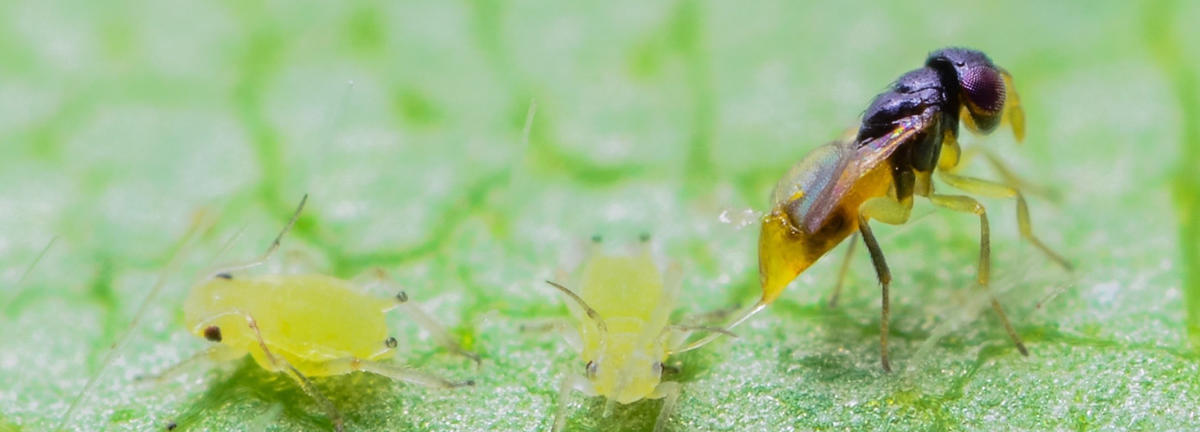
Background
The soybean aphid, originally native to Asia, is the most serious insect pest of soybeans in Minnesota. Modern control centers around the use of broad-spectrum insecticides, which are expensive and inherently risky to native pollinators and other beneficial insects. Many growers are eager for more environmentally sustainable and cost-effective solutions.
The parasitic wasp, Aphelinus certus, is one important natural enemy of the soybean aphid. Like the aphid, it was inadvertently introduced to the US from Asia in the past decade. A. certus now presents an appealing, potential alternative to exclusive chemical control, and a natural addition to the toolbox of integrated pest management (IPM) practices.
Right now, there is a gap in knowledge about how aphids and A. certus interact on Minnesota soybean fields. We do not yet know what environmental factors may affect wasps’ ability to suppress aphid populations, or how many wasps are needed to keep aphids below economically damaging levels. We also don’t know where A. certus overwinters.
This project will run field, lab, and mathematical simulations to improve our practical understanding of A. certus biocontrol. Researchers will determine the level of parasitism necessary for successful biocontrol, as well as the extent to which A. certus’ presence can reduce pesticide use. The team will also explore how A. certus biocontrol programs could protect two endangered prairie butterflies in western Minnesota—the Powesheik skipperling and the Dakota skipper.
Research questions
- How effective is A. certus in suppressing soybean aphid populations in fields across Minnesota?
- Where is A. certus currently in Minnesota and how abundant is it?
- Where does A. certus overwinter in Minnesota? In soybean fields, on buckthorn, in soybean aphids (which overwinter on buckthorn) and/or in a different aphid host?
- What population of A. certus is necessary to suppress soybean aphid populations below the economic spray threshold?
Outcomes
Based on a combination of laboratory, field, and theoretical studies, results indicate that the parasitoid wasp A. certus provides sufficient mortality of soybean aphids to substantially decrease the need to apply insecticides against this pest. This research led to new analytical tools to analyze the ability of the parasitoid A. certus to control populations of the soybean aphid. It also provided novel information on the primary overwintering site of the parasitoid (within soybean fields) and aspects of its overwintering and diapausing strategy. This information can be used to predict when A. certus adults will emerge in a given field season. Lastly, the research quantified the extent of control provided by this parasitoid and generated novel hypotheses for how control can be improved.
The research team generated an analytical tool using a stage-based matrix modeling approach. The model can be modified based on environmental and life-history characteristics for this or similar host-parasitoid systems and the underlying R code is available upon request from the authors.
Publications
- Cold tolerance and overwintering survival of Aphelinus certus (Hymenoptera: Aphelinidae), a parasitoid of the soybean aphid (Hemiptera: Aphididae) in North America (Bulletin of Entomological Research, 2023)
- A phylogenetic perspective on parasitoid host ranges with implications for biological control (Current Opinion in Insect Science, 2021)
- Parasitoid-mediated indirect interactions between unsuitable and suitable hosts generate apparent predation in microcosm and modeling studies (Ecology & Evolution, 2021)
- A field-based assessment of the parasitoid Aphelinus certus as a biological control agent of soybean aphid in North America (Biological Control, 2020)
- Density-dependent lifespan and estimation of life expectancy for a parasitoid with implications for population dynamics (Oecologia, 2020)
- Population Ecology of Aphelinus certus, an Adventive Parasitoid of Soybean Aphid in North America, with Implications for Biological Control (dissertation, University of Minnesota ProQuest Dissertations Publishing, 2020)
- A matrix model describing host–parasitoid population dynamics: The case of Aphelinus certus and soybean aphid (PLOS ONE, 2019)
- Potential causes of declines in Minnesota's prairie butterflies with a focus on insecticidal control of the soybean aphid (Minnesota Invasive Terrestrial Plants and Pests Center white paper, 2017)
News and media
- Spotlight on Soybeans (MITPPC, 2019)
- Meet the parasitic wasps killing your soybean aphids, free of charge (DTN Progressive Farmer, 2018)